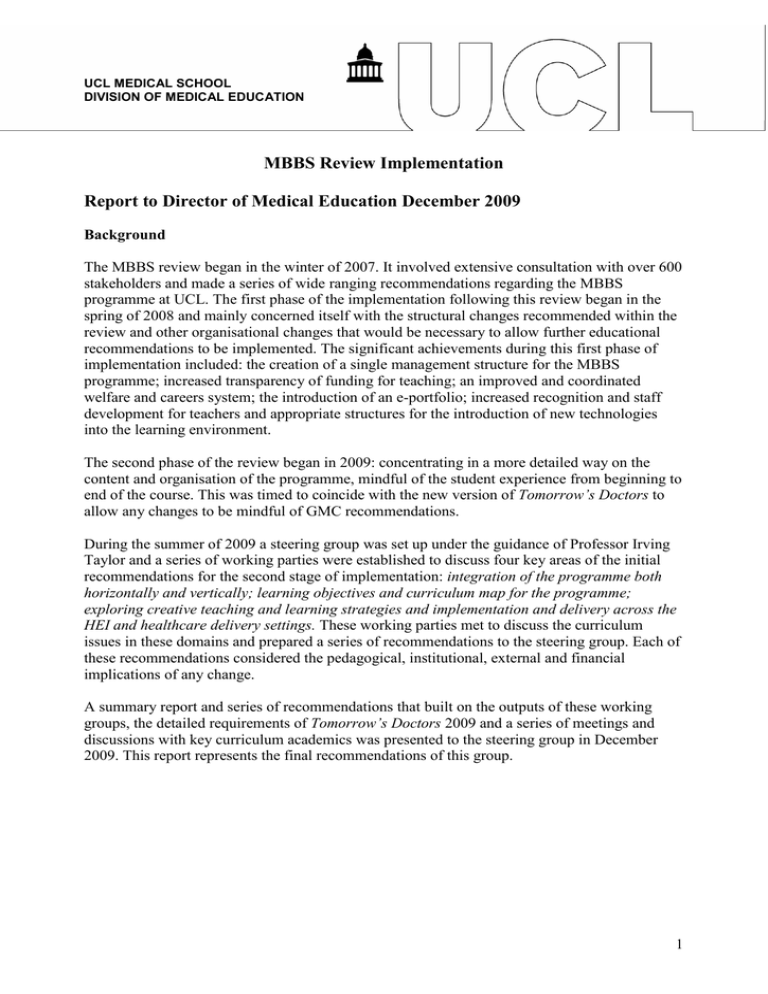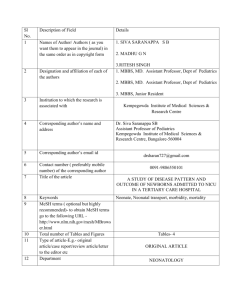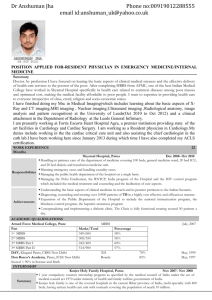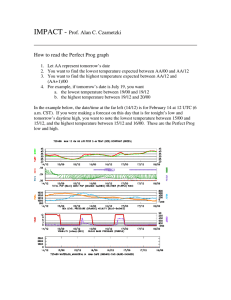MBBS Review Implementation Report to Director of Medical Education December 2009
advertisement

UCL MEDICAL SCHOOL DIVISION OF MEDICAL EDUCATION MBBS Review Implementation Report to Director of Medical Education December 2009 Background The MBBS review began in the winter of 2007. It involved extensive consultation with over 600 stakeholders and made a series of wide ranging recommendations regarding the MBBS programme at UCL. The first phase of the implementation following this review began in the spring of 2008 and mainly concerned itself with the structural changes recommended within the review and other organisational changes that would be necessary to allow further educational recommendations to be implemented. The significant achievements during this first phase of implementation included: the creation of a single management structure for the MBBS programme; increased transparency of funding for teaching; an improved and coordinated welfare and careers system; the introduction of an e-portfolio; increased recognition and staff development for teachers and appropriate structures for the introduction of new technologies into the learning environment. The second phase of the review began in 2009: concentrating in a more detailed way on the content and organisation of the programme, mindful of the student experience from beginning to end of the course. This was timed to coincide with the new version of Tomorrow’s Doctors to allow any changes to be mindful of GMC recommendations. During the summer of 2009 a steering group was set up under the guidance of Professor Irving Taylor and a series of working parties were established to discuss four key areas of the initial recommendations for the second stage of implementation: integration of the programme both horizontally and vertically; learning objectives and curriculum map for the programme; exploring creative teaching and learning strategies and implementation and delivery across the HEI and healthcare delivery settings. These working parties met to discuss the curriculum issues in these domains and prepared a series of recommendations to the steering group. Each of these recommendations considered the pedagogical, institutional, external and financial implications of any change. A summary report and series of recommendations that built on the outputs of these working groups, the detailed requirements of Tomorrow’s Doctors 2009 and a series of meetings and discussions with key curriculum academics was presented to the steering group in December 2009. This report represents the final recommendations of this group. 1 Summary of the Report A curriculum is a dynamic phenomenon that needs constant attention and refocusing to remain fit for purpose in training the doctors of tomorrow. As we review the curriculum and explore opportunities to improve the curriculum we need to be mindful that we, as the faculty with a responsibility for the curriculum, are considering everything a school does to achieve its goals rather than the more narrow conception of a curriculum as what is prescribed to be taught (Alexander in Hall et al, 2008). The recommendations within this report represent a more strategic and coherent approach to managing and developing the curriculum; moving from a position of managing the status quo to becoming more change-orientated and responsive to the needs of students and the changing health provider landscape. The current policy milieu, particularly the new guidance within Tomorrow’s Doctors 2009 and our outstanding requirements from the last QUABME review, mean that the option for no change is not an option and that our areas of focus need to be guided by policy recommendations. There is much that is good about our current curriculum but such a large and complex course is difficult to manage and regularly review. A significant mapping process must be our primary and most urgent focus, to ensure planned changes work with existing strengths. This review process has revealed a small number of major concrete pedagogical changes that would significant improve the curriculum. Many of the changes overlap with an overall direction towards a more longitudinal approach to the MBBS programme to allow: meaningful and sustained early patient contact; integration of learning; more purposeful and relevant professional development which is more closely linked with a longitudinal approach to professionalisation and preparation for practice; and less fragmentation of learning in the workplace to provide more opportunities for identity formation as a doctor. There are a number of ongoing changes to the health provider landscape that also compel us to consider more generic and flexible attachments in phases 2 and 3 and a review of potential providers of workplace-based learning. We also need to prepare our students to work within these new healthcare environments. These changes should also encourage us to look towards key areas for preparation for contemporary practice including multiprofessional learning opportunities, e-learning and use of IT and patient safety issues. Widespread changes to content and content organisation, significant shifts in pedagogical approaches, a reorientation of learning, more coordinated and longitudinal approaches to the achievement of broader aims, and alternatives for the site of delivery the curriculum all require an extensive consultation process to ensure buy-in to the unsettling process of change and the necessary upheaval and temporary increase in workload that is associated with bringing about change. To ensure the changes are enduring and that we are prepared for the next and subsequent round of reviews we need to ensure dedicated new appointments to a number of areas of curriculum development. Newly appointed faculty and newly created roles will need to articulate closely with the related existing areas of quality assurance, staff development and medical school administration. 2 Overall objectives for stage 2 of the implementation of the MBBS review1 These main recommendations can be summarised as: 1. Having clear overall aims and objectives for the MBBS course: 1.1. articulating a clear curriculum plan that is understood by all stakeholders 1.2. creating a checklist of when key skills and competencies are learnt and assessed 1.3. mapping the curriculum against Tomorrows’ Doctors key recommendations 2. Improving integration across the course: 2.1. ensuring vertical and horizontal integration 2.2. ensuring all science2 teaching has a clinical focus/highlights clinical relevance and all clinical teaching emphasises the scientific underpinning of clinical practice 2.3. develop in conjunction with attention to the overall curriculum objectives, a series of core conditions: that re either common or rare but important/illustrative 2.4. better integration between the vertical modules and the rest of the course 3. Ensuring the programme takes a patient centred approach 3.1. increasing patient involvement in both the curriculum and in teaching sessions from the early years 3.2. increased use of expert patients, simulations and practice-oriented e-learning 3.3. ensuring patient safety is integrated into the curriculum 4. Ensuring preparation for practice is a key feature of the course 4.1. ensuring the curriculum contains learning from other healthcare professionals 4.2. focusing on preparation for practice from the earliest opportunities, increasing over time 5. Ensuring delivery is mindful of educational objectives and changes in the provider landscape 5.1. Developing a wider range of settings for education delivery mindful of the changing provider landscape 5.2. Developing longer attachments with more generic objectives in phase 2 to allow identity formation and professionalisation and to maintain flexibility of where and by whom teaching is delivered. 5.3. Developing and enhancing current e-learning and IT resources 5.4. Investing in learning resources to improve our students’ access to information regardless of learning venue. 1 Many of the recommendations of the working parties overlapped considerably and suggested changes were mostly closely aligned with those proposed by Tomorrow’s Doctor 2009. Further objectives have been added following a detailed review of the final version of Tomorrow’s Doctors. 2 By science we refer to the biomedical, social and behavioural sciences. 3





